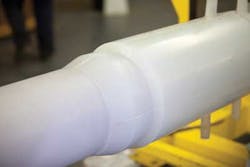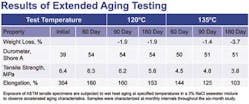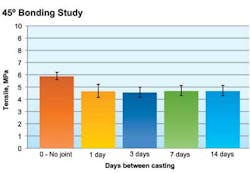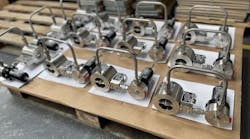Brian Swanton
Dow Corning Corp.
Subsea oil and gas operations are moving into deeper water and tapping reservoirs well below the seafloor. Handling production with much higher pressures and hotter temperatures in cold waters demands balancing risks between capex and opex. Extended equipment life and optimized flow are critical. More reliable, cost-efficient, and lower-risk thermal insulation is needed to maintain flow in the pipes above the hydrate formation and wax appearance temperatures to prevent blockages and to provide sufficient no-touch time for troubleshooting during shutdowns.
Advanced subsea wet insulation systems based on solid silicone science may be a viable option to syntactic foams or syntactic silicones, as well as to wet insulation systems based on polyurethane, epoxy, polyether, phenolic, or specialized polymers.
A new engineered thermal insulation solution is being introduced to help meet the flow assurance needs of subsea oil and gas operations. Formulated with silicone expertise, application experience, and industry collaboration, the proposed advanced technology from Dow Corning Corp. for subsea wet insulation systems uses a solid silicone, unlike syntactic foams or silicone resins that contain glass microspheres.
Developed to insulate high-pressure/high-temperature (HP/HT) equipment used in deep- water production infrastructure and tiebacks, the new XTI-1003 RTV Silicone Rubber Insulation potentially offers several advantages. Ongoing tests of performance compared to producer specifications and applicator requirements indicate improvements such as: simplicity of use; ease of application; increased joint strength; excellent flexibility; thermal stability; and anticipated gains in field performance, reliability, and service life.
Solid silicone science
The company's new product, the XTI-1003 RTV Silicone Rubber Insulation system, is a two-part, high-strength silicone rubber for subsea wet insulation. It is designed to assist in providing more reliability, added cost-efficiency, and reduced performance risks in harsh subsea environments. The non-syntactic technology does not use glass microspheres while emphasizing joint strength and resistance to extreme pressures.
Based on room-temperature-curing (RTV), liquid silicone rubber (LSR) elastomer is easy to mix and apply. It cures to a durable, flexible, translucent rubber without potentially harmful by-products. Projected insulation perfor-mance advantages, as well as coating-application benefits, are:
- Thermal stability across a wide temperature range
- Good insulating properties for longer no-touch times
- Excellent flexibility and resistance to cracking
- Reduced degradation with less potential for water ingress
- Easier processing for curved, straight-line, and flexible sections
- Durable joint integrity with silicone-to-silicone bonding
- Fast addition-reaction cure in unlimited thickness that can be accelerated with heat.
In providing a simple, yet robust, subsea wet insulation system, XTI-1003 RTV can help optimize flow assurance and manage risks on HP/HT subsea production architecture from wellheads to tieback components. Potential applications for the new silicone insulation systems could include:
- Wellheads
- Subsea trees
- Pipeline end manifolds (PLEMs)
- Pipeline end terminations (PLETs)
- Jumpers and spoolpieces
- Sleds
- Flowline ends and riser ends
- Flange connections.
Performance profile
Compared to the Silastic E RTV silicone rubber used in earlier syntactic thermal insulation systems, XTI-1003 RTV exhibits a number of improvements as a solid silicone wet insulation system. These include advancements in flexibility, joint bonding, tear strength, and elongation, which show improved high-temperature performance. This non-syntactic silicone rubber also has better resistance to degradation by reducing potential for water ingress at elevated temperatures. This is an advantage compared with syntactic insulation, which may have voids from microsphere collapse as a result of subsea pressure.
For deepwater subsea applications, typical wet insulation is molded directly around the equipment with no need for an outer protective jacket. The insulation is exposed directly to the cold seawater on the outer surface, with the inner surface exposed to the high-temperature fluids flow. Critical design parameters are thermal conductivity, insulation thickness, and specific heat capacity. Primary concerns are resistance to degradation, high-temperature stability, and physical durability in both equipment deployment and saltwater production operations. The silicone rubber insulation exhibits the following physical properties when cured:
- Specific gravity: 1.08
- Durometer hardness: 40
- Tensile strength: 5.5 MPa
- Elongation: 400%
- Thermal conductivity (dry): 0.196 W/mK
- Thermal conductivity (aged, wet): 0.201 W/mK
- Specific heat capacity at 135°C: 1.79 J/g/°C.
In a 45° bonding study during which material was cast over a two-day period to simulate actual insulation application on subsea equipment, excellent silicone-to-silicone bond strength was achieved. This underscores the capability of the new technology to establish strong joint integrity that can withstand deepwater pressures and equipment movement. With the high tensile strength and elongation demonstrated during testing, excellent joint strength in both rigid and flexible sections is possible.
In testing by an insulation coating specialist in conjunction with an independent lab, the low thermal conductivity of XTI-1003 RTV was verified. Qualification requirements have been met for process temperatures up to 115°C (239ºF), and ongoing testing is expected to certify the technology for applications to 135°C (275ºF) and possibly to 150°C (302ºF) or higher.
Further independent testing under specific application conditions has helped verify claims for durability, thermal stability, and excellent silicone-to-silicone adhesion. Cured samples of the new solid silicone insulation were tested for extended intervals, both submerged and exposed to elevated temperatures. Performance was documented at 120°C, 135°C and 150°C, and results at the higher temperatures indicated improved performance over silicones used in syntactic systems.
The silicone rubber insulation performed well in simulated service tests, extended service tests, and arctic conditions testing. Extensive 150°C heat-aging testing also was conducted and is being validated independently with further extended testing.
Simplicity reduces risks
Even with its performance during testing, this new silicone rubber insulation still must be applied properly and professionally. Experienced coating specialists are responsible for prescribed application techniques and procedures. Here, the technology adds a measure of application ease to reduce risks of inadequate adhesion or inconsistent joint integrity.
Typically, the most practical application methods for insulating complex-shaped components with this solid silicone thermal insulation system will be cast in place, pre-cast, or bonded to itself on metal components. Since subsea metal components can have various corrosion coatings, a primer usually is recommended to ensure maximum insulation adhesion.
Supplied as a two-part system, the low-viscosity silicone rubber base and curing agent are mixed in a 10:1 ratio and then pumped into the mold using conventional equipment. Care must be taken to avoid excessive air entrapment, so applicators should fill molds from the bottom up and provide sufficient air vents toward the top of molds.
Once mixed, XTI-1003 RTV has a working time of approximately 90 minutes at a moderate temperature (23°C, or 73ºF). The addition-reaction cure (polymerization) typically requires up to 12 hours at room temperature before demolding, or the material may need to be heated. Curing will accelerate in warmer temperatures. If the insulation is being cast in lower temperatures, up to 24 hours may be needed before molds are removed.
Dow Corning is working with insulation coating specialists to establish application processes and quality-control procedures for this technology. Equipment-specifying producers would contract these specialists to meet their equipment thermal insulation requirements.








